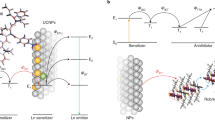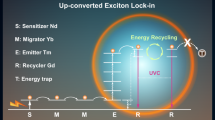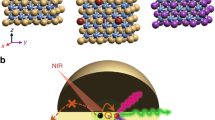Abstract
Efficient photon upconversion at low light intensities promises major advances in technologies spanning solar energy harvesting to deep-tissue biophotonics. Here, we discover the critical mechanisms that enable near-infrared dye antennas to significantly enhance performance in lanthanide-doped upconverting nanoparticle (UCNP) systems, and leverage these findings to design dye–UCNP hybrids with a 33,000-fold increase in brightness and a 100-fold increase in efficiency over bare UCNPs. We show that increasing the lanthanide content in the UCNPs shifts the primary energy donor from the dye singlet to its triplet, and the resultant triplet states then mediate energy transfer into the nanocrystals. Time-gated phosphorescence, density functional theory, singlet lifetimes and triplet-quenching experiments support these findings. This interplay between the excited-state populations in organic antennas and the composition of UCNPs presents new design rules that overcome the limitations of previous upconverting materials, enabling performances now relevant for photovoltaics, biophotonics and infrared detection.
This is a preview of subscription content, access via your institution
Access options
Access Nature and 54 other Nature Portfolio journals
Get Nature+, our best-value online-access subscription
$29.99 / 30 days
cancel any time
Subscribe to this journal
Receive 12 print issues and online access
$209.00 per year
only $17.42 per issue
Buy this article
- Purchase on Springer Link
- Instant access to full article PDF
Prices may be subject to local taxes which are calculated during checkout




Similar content being viewed by others
References
Zou, W., Visser, C., Maduro, J. A., Pshenichnikov, M. S. & Hummelen, J. C. Broadband dye-sensitized upconversion of near-infrared light. Nat. Photon. 6, 560–564 (2012).
Zhou, B., Shi, B., Jin, D. & Liu, X. Controlling upconversion nanocrystals for emerging applications. Nat. Nanotech. 10, 924–936 (2015).
Briggs, J. A., Atre, A. C. & Dionne, J. A. Narrow-bandwidth solar upconversion: case studies of existing systems and generalized fundamental limits. J. Appl. Phys. 113, 124509 (2013).
Park, Y. Il, Lee, K. T., Suh, Y. D. & Hyeon, T. Upconverting nanoparticles: a versatile platform for wide-field two-photon microscopy and multi-modal in vivo imaging. Chem. Soc. Rev. 44, 1302–1317 (2014).
Liu, Y. et al. Amplified stimulated emission in upconversion nanoparticles for super-resolution nanoscopy. Nature 543, 229–233 (2017).
Wang, C., Li, X. & Zhang, F. Bioapplications and biotechnologies of upconversion nanoparticle-based nanosensors. Analyst. 141, 3601–3620 (2016).
Wu, X. et al. Dye-sensitized core/active shell upconversion nanoparticles for optogenetics and bioimaging applications. ACS Nano 10, 1060–1066 (2016).
Hososhima, S. et al. Near-infrared (NIR) up-conversion optogenetics. Sci. Rep. 5, 16533 (2015).
Schmidt, T. W. & Castellano, F. N. Photochemical conversion: the primacy of kinetics. J. Phys. Chem. Lett. 5, 4062–4072 (2014).
Schulze, T. F. & Schmidt, T. W. Photochemical upconversion: present status and prospects for its application to solar energy conversion. Energy Environ. Sci. 8, 103–125 (2015).
Olivier, J. H. et al. Near-infrared-to-visible photon upconversion enabled by conjugated porphyrinic sensitizers under low-power noncoherent illumination. J. Phys. Chem. A 119, 5642–5649 (2015).
Gargas, D. J. et al. Engineering bright sub-10-nm upconverting nanocrystals for single-molecule imaging. Nat. Nanotech. 9, 300–305 (2014).
Wu, S. et al. Non-blinking and photostable upconverted luminescence from single lanthanide-doped nanocrystals. Proc. Natl Acad. Sci. USA 106, 10917–10921 (2009).
Park, Y. Il et al. Nonblinking and nonbleaching upconverting nanoparticles as an optical imaging nanoprobe and T1 magnetic resonance imaging contrast agent. Adv. Mater. 21, 4467–4471 (2009).
Chen, G. et al. Energy-cascaded upconversion in an organic dye-sensitized core/shell fluoride nanocrystal. Nano Lett. 15, 7400–7407 (2015).
Shao, W. et al. Tunable narrow band emissions from dye-sensitized core/shell/shell nanocrystals in the second near-infrared biological window. J. Am. Chem. Soc. 138, 16191–16195 (2016).
Chen, G. et al. Efficient broadband upconversion of near-infrared light in dye-sensitized core/shell nanocrystals. Adv. Opt. Mater. 4, 1760–1766 (2016).
Lee, J. et al. Ultra-wideband multi-dye-sensitized upconverting nanoparticles for information security application. Adv. Mater. 29, 1603169 (2017).
Du, C., Wang, H., Yang, F. & Hammel, P. C. Systematic variation of spin–orbit coupling with d-orbital filling: large inverse spin Hall effect in 3d transition metals. Phys. Rev. B 90, 140407(R) (2014).
Klink, S. I., Keizer, H. & van Veggel, F. C. J. M. Transition metal complexes as photosensitizers for near-infrared lanthanide luminescence. Angew. Chem. Int. Ed. 39, 4319–4321 (2000).
Beeby, A., Faulkner, S., Parker, D. & Williams, J. A. G. Sensitised luminescence from phenanthridine appended lanthanide complexes: analysis of triplet mediated energy transfer processes in terbium, europium and neodymium complexes. J. Chem. Soc. Perkin Trans. 2, 1268–1273 (2001).
Faulkner, S., Natrajan, L. S., Perry, W. S. & Sykes, D. Sensitised luminescence in lanthanide containing arrays and d–f hybrids. Dalton Trans. 3890–3899 (2009).
Klink, S. I. et al. A systematic study of the photophysical processes in polydentate triphenylene-functionalized Eu3+. J. Phys. Chem. A 104, 5457–5468 (2000).
Bunzli, J. G. & Piguet, C. Taking advantage of luminescent lanthanide ions. Chem. Soc. Rev. 34, 1048–1077 (2005).
Thompson, N. J. et al. Energy harvesting of non-emissive triplet excitons in tetracene by emissive PbS nanocrystals. Nat. Mater. 13, 1039–1043 (2014).
Cedric, M., Garakyaraghi, S., Razgoniaeva, N., Zamkov, M. & Castellano, F. N. Direct observation of triplet energy transfer from semiconductor nanocrystals. Science 351, 369–372 (2016).
Tabachnyk, M. et al. Resonant energy transfer of triplet excitons from pentacene to PbSe nanocrystals. Nat. Mater. 13, 1033–1038 (2014).
Agbo, P., Xu, T., Sturzbecher-Hoehne, M. & Abergel, R. J. Enhanced ultraviolet photon capture in ligand-sensitized nanocrystals. ACS Photon. 3, 547–552 (2016).
Huang, Z. et al. Hybrid molecule-nanocrystal photon upconversion across the visible and near-infrared. Nano. Lett. 15, 5552–5557 (2015).
Piland, G. B., Huang, Z., Lee Tang, M. & Bardeen, C. J. Dynamics of energy transfer from CdSe nanocrystals to triplet states of anthracene ligand molecules. J. Phys. Chem. C 120, 5883–5889 (2016).
Wang, F. et al. Tuning upconversion through energy migration in core–shell nanoparticles. Nat. Mater. 10, 968–973 (2011).
Marling, J. B., Gregg, D. W. & Wood, L. Chemical quenching of the triplet state in flashlamp-excited liquid organic lasers. Appl. Phys. Lett. 17, 527–530 (1970).
Pappalardo, R., Samelson, H. & Lempicki, A. Long pulse laser emission from rhodamine 6G using cyclooctatetraene. Appl. Phys. Lett. 16, 267–269 (1970).
Schols, S., Kadashchuk, A., Heremans, P., Helfer, A. & Scherf, U. Triplet excitation scavenging in films of conjugated polymers. ChemPhysChem 10, 1071–1076 (2009).
Schaap, A. P. Singlet Molecular Oxygen (Dowden, Hutchinson, & Ross: Stroudsburg, PA, 1976).
Gorka, A. P., Nani, R. R., Zhu, J., Mackem, S. & Schnermann, M. J. A near-IR uncaging strategy based on cyanine photochemistry. J. Am. Chem. Soc. 136, 14153–14159 (2014).
Han, Y. et al. Degradation observations of encapsulated planar CH3NH3PbI3 perovskite solar cells at high temperatures and humidity. J. Mater. Chem. A 3, 8139–8147 (2015).
Ow, H. et al. Bright and stable core–shell fluorescent silica nanoparticles. Nano Lett. 5, 113–117 (2005).
Pokhrel, M., Kumar, G. A. & Sardar, D. K. Highly efficient NIR to NIR and VIS upconversion in Er3+ and Yb3+ doped in M2O2S (M = Gd, La, Y). J. Mater. Chem. A 1, 11595–11606 (2013).
Fischer, S., Bronstein, N. D., Swabeck, J. K., Chan, E. M. & Alivisatos, A. P. Precise tuning of surface quenching for luminescence enhancement in core–shell lanthanide-doped nanocrystals. Nano Lett. 16, 7241–7247 (2016).
Johnson, N. J. J. et al. Direct evidence for coupled surface and concentration quenching dynamics in lanthanide-doped nanocrystals. J. Am. Chem. Soc. 139, 3275–3282 (2017).
Chan, E. M., Levy, E. S. & Cohen, B. E. Rationally designed energy transfer in upconverting nanoparticles. Adv. Mater. 27, 5753–5761 (2015).
Acknowledgements
The authors thank S. Fischer, K. Raymond and K. Yao for helpful discussions, and T. Chen for her invaluable experimental assistance. This work was supported by the National Science Foundation SAGE IGERT fellowship (to D.J.G.) and the Chinese Scholarship Council fellowship (B.T.). Portions of this research were supported by the Global Research Laboratory (GRL) Program through the National Research Foundation of Korea (NRF) funded by the Ministry of Science and ICT (no. 2016911815). This work was performed at the Molecular Foundry and was supported by the Office of Science, Office of Basic Energy Sciences, of the US Department of Energy (contract no. DE-AC02-05CH11231). The computational work performed here was supported by the Director, Office of Science, Chemical Sciences, Geosciences and Biosciences Division of the US Department of Energy, under contract no. DEAC02-05CH1123.
Author information
Authors and Affiliations
Contributions
The scientific concepts, ideas and experimental designs were the result of interactions and discussions between D.J.G., P.J.S., B.E.C., N.J.B., E.M.C. and Y.D.S. D.J.G., E.M.C., N.A.T., C.A.T. and B.T. synthesized the nanoparticles. D.J.G., N.J.B. and E.S.B. conducted the spectroscopic measurements. D.J.G. and E.M.C. conducted the QY measurements. S.M.H. and J.B.N. performed the theoretical modelling. B.S. and S.A. conducted the electron microscopy. D.J.G., N.J.B., E.M.C., B.E.C. and P.J.S. wrote the paper, in coordination with all the authors.
Corresponding authors
Ethics declarations
Competing interests
The authors declare no competing interests.
Additional information
Publisher’s note: Springer Nature remains neutral with regard to jurisdictional claims in published maps and institutional affiliations.
Supplementary information
Supplementary Information
Supplementary Methods; Supplementary Figures 1–16; Supplementary Table 1; Supplementary discussion; and Supplementary references.
Rights and permissions
About this article
Cite this article
Garfield, D.J., Borys, N.J., Hamed, S.M. et al. Enrichment of molecular antenna triplets amplifies upconverting nanoparticle emission. Nature Photon 12, 402–407 (2018). https://doi.org/10.1038/s41566-018-0156-x
Received:
Accepted:
Published:
Issue Date:
DOI: https://doi.org/10.1038/s41566-018-0156-x
This article is cited by
-
Size-dependent lanthanide energy transfer amplifies upconversion luminescence quantum yields
Nature Photonics (2024)
-
Fully Integrated Ultra-thin Intraoperative Micro-imager for Cancer Detection Using Upconverting Nanoparticles
Molecular Imaging and Biology (2023)
-
Vacancy-engineering-mediated activation of excitonic transition for boosting visible-light-driven photocatalytic oxidative coupling of amines
Nano Research (2023)
-
A hybrid erbium(III)–bacteriochlorin near-infrared probe for multiplexed biomedical imaging
Nature Materials (2021)
-
Full shell coating or cation exchange enhances luminescence
Nature Communications (2021)



